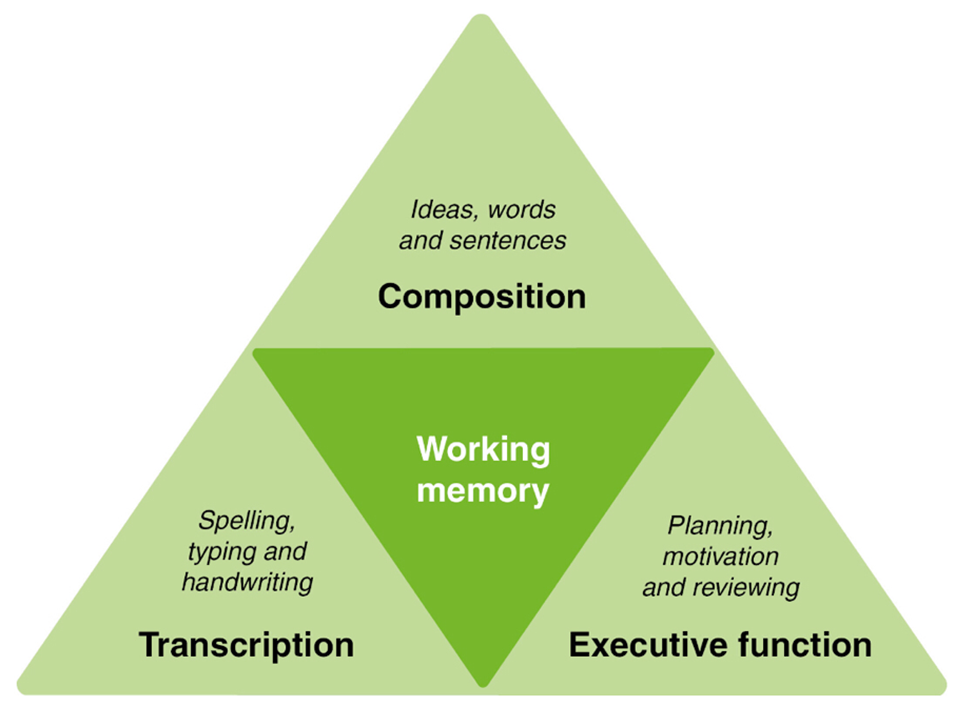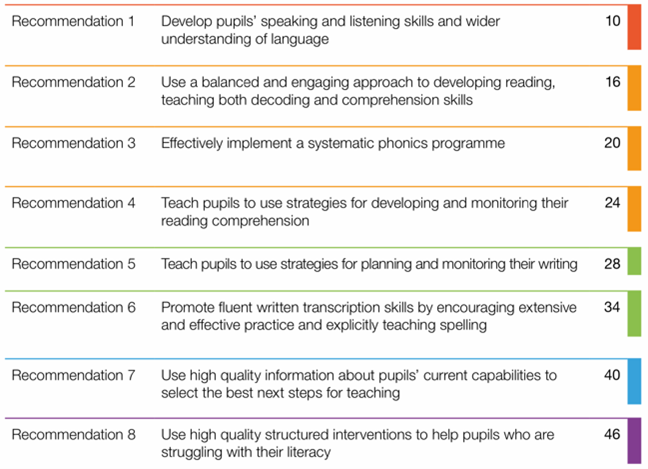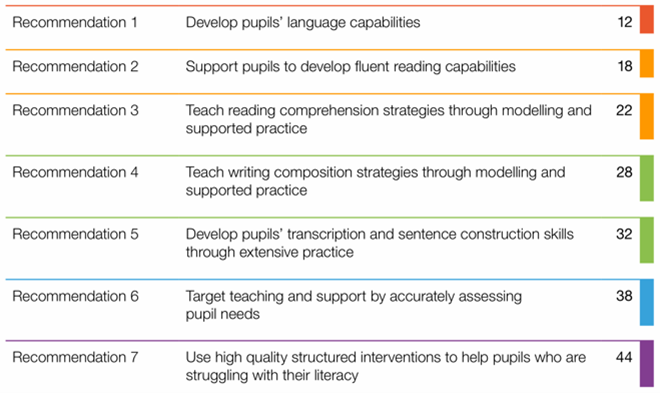Writing
To help us think about the teaching of writing, we use the ‘simple view of writing’ model, taken from ‘Closing the Writing Gap’ by Alex Quigley (originally by Berlinger et al, 2002).

It helps to understand that the writing process has a number of elements which all compete for working memory. When we are asking children to write, we are asking them to simultaneously regulate their own learning (think about the goal for the task and how they are getting on while managing emotions and potential distractions); to come up with ideas, draw on their own context knowledge, decide on order and structure, remember success criteria etc. - all while spelling accurately and writing legibly.
Thinking about the writing process in this way can help us plan activities which reduce the cognitive load on children’s working memory by scaffolding and supporting some areas while asking children to work on others (e.g by giving a writing frame or by planning a story as a class so that children can focus on composition).
It can also help us to diagnose barriers to writing and create targeted next steps for individual learners or adapted whole-class planning. For example, a number of children struggling for ideas may need additional lesson focus time exploring the context of the proposed writing through stimulus activities. An individual pupil struggling with composition may need a selection of words an images to fill a gap in context knowledge and picture an unfamiliar setting.
We have also developed our practices and thinking about writing using the EEF guidance on improving literacy at KS1 and KS2. From this guidance and further reading, we have created 12 characteristics of writing lessons in our school – this is a working document and, in the spirit of writing, we will revise it as we continue to learn.


Writing lessons at our school have the following characteristics. If you would like to find out more, the detail of our curriculum can be found in the curriculum and handbook document at the bottom of this page.
1. Using a stimulus text
The Easton Royal curriculum is built on high quality texts in order to constantly promote a culture of reading and language development. Our writing units are each based on a text which is used for context and creative ideas. One text might span as long as a half term and is used as the stimulus for several units/different forms of writing (e.g the text ‘Varmints’ may be used as the stimulus for a 2 week narrative unit on creating setting and then a further 3 week unit on persuasive texts. Children might use the first part of varmints to inspire their own rich descriptions and then the second part of the story as context to write a persuasive letter about looking after nature). The stimulus text is different from the model text. We select excellent texts from the centre of literacy in primary education (CLPE).
2. Using a 'mentor' (model) text
Mentor texts describe good examples of writing, which offer pupils ideas and exhibit the demands of the writing task. There needs to be careful teacher judgement about whether expert models by professional authors are preferable to more accessible examples from peers. We can apply the Goldilocks principle to mentor texts: they should not be too easy nor too hard – but just right. For example, it may mean the difference between reading an expert article from a historian on the causes of World War One or a past essay from a pupil. Of course, you can usefully deploy both to good effect.
3. Graphic representations of text structure
Studies quoted by the EEF show that children benefit from explicit teaching about the structure of narrative and information texts. We use a consistent image of each text type (we use the images by Sue Palmer) and children revisit them repeatedly throughout their time at ERA. The image is also added ot the working wall during the unit of study.
4. Co-constructed success criteria
Children will be guided to analyse the mentor text(s) and will use it to create success criteria for the working wall – ‘what makes this effective?’, ‘why do these sentences not really work as a description?’ ‘What will our descriptive sentences need to be like?’. Success criteria will usually be based on age.
5. Shared writing/Modelling
Teachers use flip charts/visualisers to work with children to write an example. They model their thinking and acceptance and rejection of ideas out loud as well as their spelling, grammar and layout choices. Shared writing should be based around a similar stimulus but not the same one children have for their task.
6. Guided writing
Teachers use formative assessment during and in between lessons to select individuals or small groups to work with on guided writing. The focus for these sessions (during the class independent writing) will be supporting children’s progress on a targeted objective (e.g writing compound sentences).
7. Visualiser stops (co-editing)
As children write independently, the teacher selects appropriate moments to share their ideas with the class and look together at what is going well and why. Children are encouraged to share, read and edit each other’s work. We use cameras connected to giant smart screens in class to share children's work with the class, celebrate personal successes and learn to edit, revise and redraft together in real-time.
8. Use of stimulus strategies/pre-writing activities
We have a number of strategies to get children’s creative ideas flowing before they are asked to write; these also make writing lessons memorable and fun.
9. Explicit teaching of the planning stage
We have progressive expectations of planning according to age. Planning will also differ according to text type. We use graphic organisers for planning and these images and formats as children move through the school to help them to remember how they work and allow children to gradually develop the sophistication of their plans. Teachers model and teach the planning stage so that children are ultimately capable of doing these things independently.
10. Explicit teaching of editing, revising and redrafting
Editing, revising and redrafting happen in every writing unit and for every child, showing it is a positive and essential part of the writing process and that it is not linked to failure. Children are given a single focus (e.g sentence structure, purpose or powerful words) to look for and improve. This is sometimes done through the use of editing stations.
11. Practice!
The vast majority of lessons include an opportunity for children to write, experiment and practice with a taught skill or objective (e.g power of 3 or ‘who’ relative clause). Where possible, children write a series of sentences rather than single sentence exercises. These activities help teachers with formative assessment judgements and in selection of children for guided writing.
12. Independent, extended writing
Children are given very regular opportunities to write at length, incorporating elements from a series of lessons.
13. Publish, present, perform, share
Writing tasks are always for a purpose – either presenting it neatly as a book for the library, to show parents etc or practiced and read aloud formally as speaking development.
